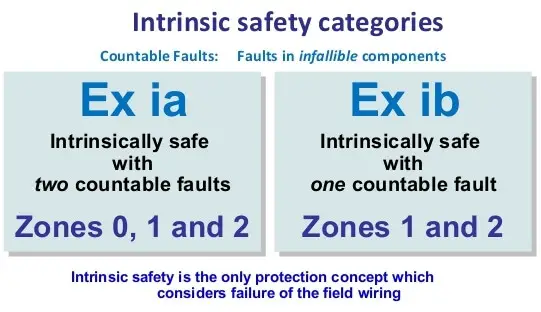
ProtectionType ia
Apparatus is designed so that it is suitable for Zone 0 & it will not cause ignition when the maximum permitted values are applied to its terminals:
a) in normal operation with application of those non-countable faults which give the most onerous condition;
b) in normal operation with application of one countable fault and those non-countable faults which give the most onerous condition; and
c) in normal operation with application of two countable faults and those non-countable faults which give the most onerous condition.
Normal operation means that the apparatus conforms to the design specification supplied by the manufacturer, and is used within electrical, mechanical, and environmental limits specified by the manufacturer.
Normal operation also includes open circuiting, shorting, and grounding of external wiring at connection facilities. When assessing or testing for spark ignition, the safety factors to be applied to voltage or current are 1.5 in conditions a and b, and 1.0 in condition c. (These factors should properly be called “test factors.”
The real safety of intrinsic safety is inherent in the use of the sensitive IEC apparatus to attempt to ignite the most easily ignitable mixture of the test gas with hundreds of sparks. This combination of conditions is many times more onerous than any likely to occur in practice.)
North American Intrinsic Safety design standards are equivalent to ia intrinsic safety.
ProtectionType ib
Apparatus is designed so that it is suitable for Zone 1, & it is assessed or tested under the conditions of a and b above, with a safety factor on voltage or current of 1.5 in the condition of a and b.
It is likely that Level of protection ic apparatus, equivalent to and replacing Type of Protection nL, suitable for use in Zone 2, will be standardized.
Figure typical grounded and ungrounded two wire intrinsically safe circuits.
Figure illustrates the principle that every ungrounded conductor entering the Division 1/Zone 0, or 1 location in this case where the transmitter or transducer is located, must be protected against unsafe voltage and current by appropriate associated apparatus. The boxes with three terminals represent barriers, independently certified protective assemblies, certified and rated according to the national standard. Nonintrinsically safe devices connected to the barrier need only be suitable for their location, and must not contain voltages higher than the Um rating of the barrier.
Many barriers are passive, consisting of current limiting resistors and voltage limiting diodes in appropriate configuration and redundancy to meet the requirements of the standard. Others have active current or voltage limiting. Both types may be combined with other circuitry for regulating voltages, processing signals, etc. The user should follow the recommendation of the intrinsically safe apparatus manufacturer in the control drawing, or discuss the selection of appropriate barriers with the barrier vendor, all of whom have proven configurations for many field mounted devices.
Also Read: ISA codes for Process Instrumentation
Learn the example of flip-flop PLC program for lamps application using the ladder logic to…
In this article, you will learn the STAR DELTA programming using PLC controller to start…
Lube oil consoles of rotary equipment packages in industrial process plants are usually equipped with…
Rotating equipment packages such as pumps, compressors, turbines need the lube oil consoles for their…
This article explains how to blink lights in ladder logic with a detailed explanation video…
In this article, a simple example will teach you the conversion from Boolean algebra to…